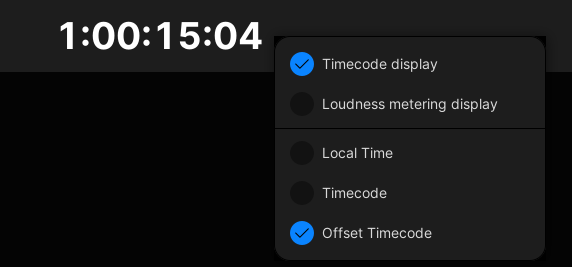mc²56 - The Pass Tree display
Passes are managed from the Pass Tree.
1. Open the Pass Tree display on the Central GUI:
At the top of the display are various fields for:
- Play, Record and Selected pass - display the current Play and Record passes (for writing new automation) and Selected pass (for editing automation). The Locate buttons automatically reveal the pass, in the Pass Tree, if it has been hidden by closing a branch.
- Punch-in and Punch-out times - define the punch-in/out timecode window.
- Glide-in and Glide-out times - define the glide times.
- Pre-roll window - defines the pre-roll tolerance for machines which pre-roll when going into Play.
- Midnight - defines the timecode offset.
The Pass Tree displays all the finished passes in memory.
Each time you revert to an earlier pass and then make updates, you start a new branch within the tree. Click on the arrows beside each branch to open or close. Or, click on Expand all at the bottom of the display to open up all branches of the Pass tree.
To avoid mixes become too large, a maximum of 10 passes are stored within each branch of the Pass tree; after the tenth pass, the first pass is deleted to make space for new data, and so on. To keep a specific pass indefinitely you should protect it; it will then be retained as one of the 10 passes with the branch.
The columns beside each pass name show its date and time stamp and whether the pass is protected (padlock icon). You can also rename or delete a pass; the Status field marks the current Play and Record pass with icons.
All passes are stored inside the Active Mix when you update or save a production. Or, if you load a different mix or production, then the Pass Tree updates accordingly.
You can use the Pass Tree to change the Play pass at a any time. For example, to A/B between two different versions of automation for a chorus or scene. See Reverting to an Earlier Pass.
You can also edit mix passes in order to combine, delete, copy, shift, insert or paste sections of automation data.
Renaming a Pass
1. Click on the pass name.
Click once to select all the text, or twice to modify an existing name (you will see a flashing cursor). |
2. Enter a new name using the keyboard.
3. To confirm, press ENTER. Or, to exit without making a change, press ESCAPE.
Protect & Delete
Protect
A protected pass cannot be deleted manually, or automatically by the system (when it reaches the 10 pass per branch limit).
1. Select a pass from the Pass Tree.
2. Right-click and select Protect, or press the PROTECT soft key.
A padlock icon indicates that the pass is now protected.
Delete
Delete removes the pass from the internal memory.
1. Select a pass from the Pass tree.
2. Right-click and select Delete, or press the DELETE soft key, to complete the operation.
Note that you cannot delete a protected pass or the current Play pass.
Setting an Offset Timecode
The Midnight field at the top of the Pass Tree display is used to offset the internal timecode of the automation system.
For example, if your mix starts at an odd timecode value and you wish to view it as starting at 00:00:00:00.
1. First, set the Central GUI headline to show the offset timecode by touching the headline and choosing Timecode display + Offset Timecode:
2. Now click in the Midnight field to enter the offset timecode:
3. Use the console keyboard to enter the timecode which you wish to correspond to midnight (00:00:00:00).
For example, you could locate to the beginning of your mix (e.g. 21:00:20:15) and enter this value as midnight.
4. Press Enter and you will see the start of your mix as 00:00:00:00 in the Central GUI time display.
5. To clear an offset, click in the Midnight field and enter 00:00:00:00.
Setting Pre-roll
Any small rewind in timecode causes the automation system to finish the pass. Often this is undesirable, as it prevents you from putting controls into write while in Stop, and then writing these values forwards on entering Play.
To avoid this problem:
1. Use the console keyboard to enter a value in ms into the Pre-roll window – for example, 50ms.
The automation system now requires a rewind of more than 50ms to finish a pass, and therefore tolerates an external machine's pre-roll when entering Play.
2. Test your entry by putting some controls into write while in Stop and pressing Play.
The controls should remain in write when you go into Play. If not, adjust the Pre-roll window to a longer time accordingly.
Note that the Pre-roll window affects how a pass can be finished; you must rewind by more than the Pre-roll window time in order to finish a pass.
Glide Time
The Glide-in time and Glide-out time fields are used in conjunction with a number of functions:
- Glide-in time - used when performing mix pass edits.
- Glide-out time - used when performing mix pass edits, and when stepping out of automation using Glide.
To adjust the glide times:
1. Either click within the Glide-in/out time box and type in a value from the console keyboard.
2. Or use the up/down arrows to adjust the time in 100 ms steps.
Both values can be adjusted from 0 to 60000ms (60 seconds).